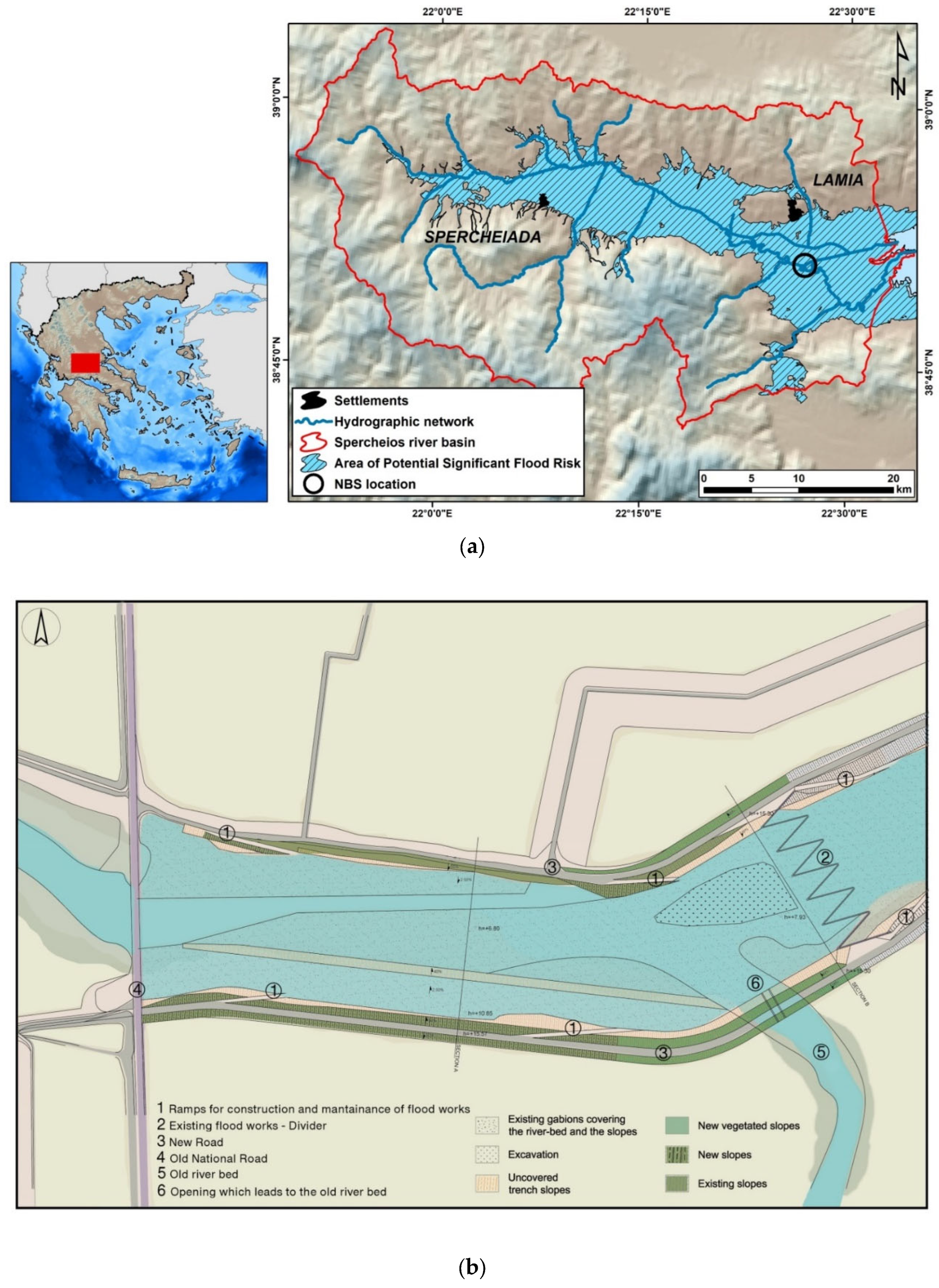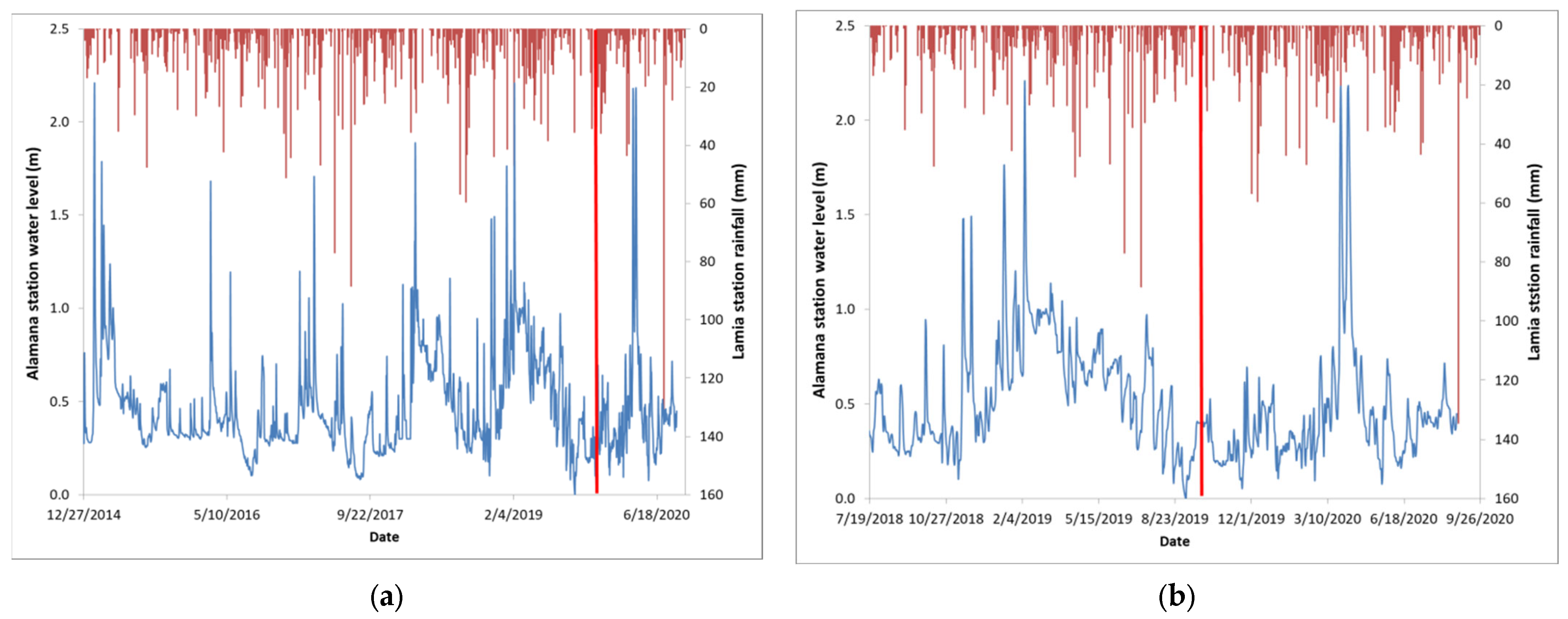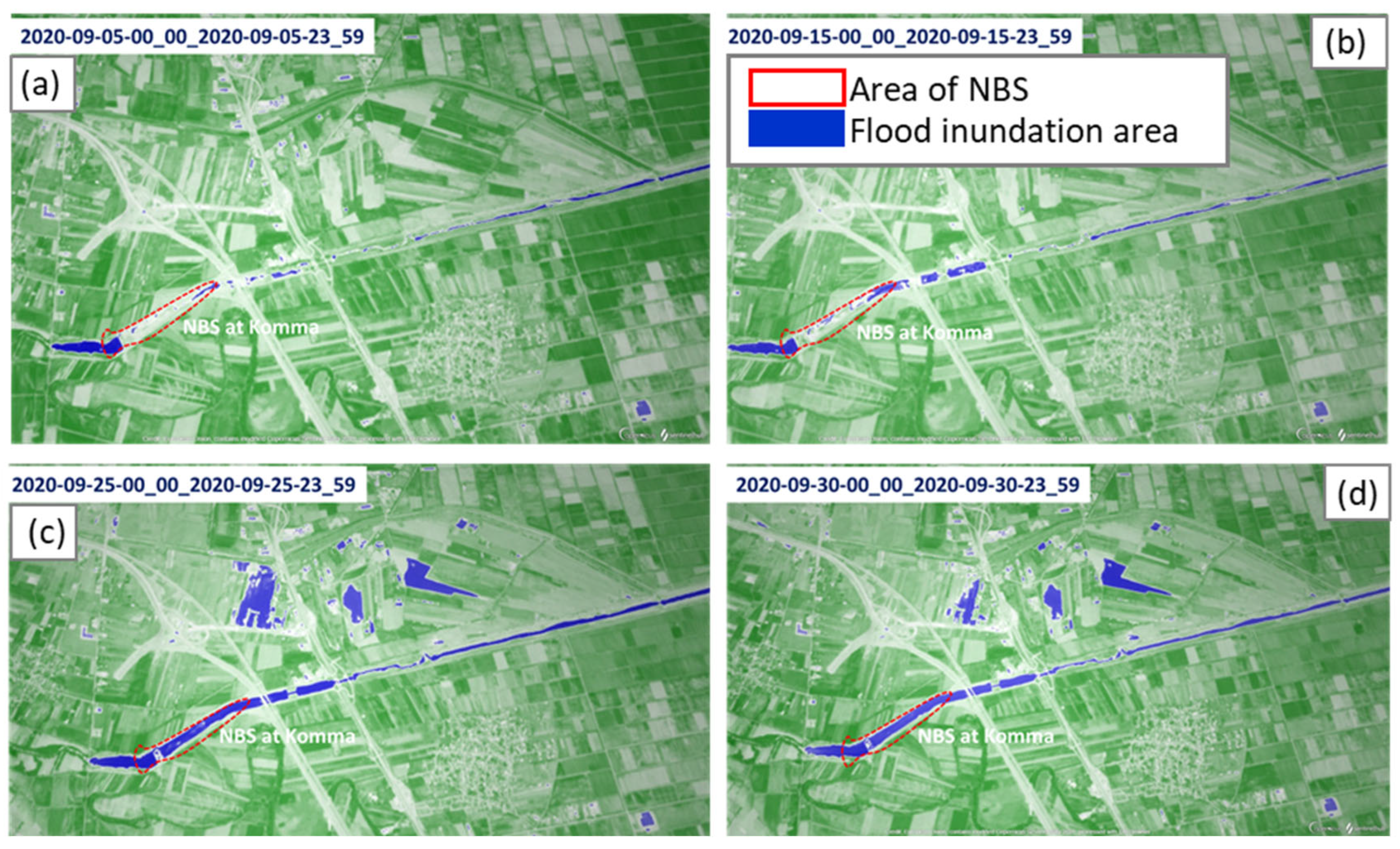Evaluating Nature-Based Solution for Flood Reduction in Spercheios River Basin Part 2: Early Experimental Evidence
Abstract
:1. Introduction
2. NBS Efficiency Using Monitoring Stations
2.1. Monitoring Surface Water Level
2.2. Monitoring Groundwater Level
3. Monitoring Flood Areas and Nature-Based Solutions Using Spaceborne Imagery
4. Vegetation Index Anomalies
5. Conclusions
Author Contributions
Funding
Data Availability Statement
Conflicts of Interest
References
- Paul, S.H.; Sharif, H.O.; Crawford, A.M. Fatalities Caused by Hydrometeorological Disasters in Texas. Geosciences 2018, 8, 186. [Google Scholar] [CrossRef]
- McBean, G. Hydrometeorological Hazards. In Encyclopedia of Earth Sciences Series; Springer: Dordrecht, The Netherlands, 2013; pp. 497–507. [Google Scholar]
- Debele, S.P.; Kumar, J.; Sahani, B.; Marti-Cardona, S.B.; Mickovski, L.S.; Leo, F.; Porcù, F.; Bertini, D.; Montesi, Z.; Vojinovic, S.; et al. Nature-based solutions for hydro-meteorological hazards: Revised concepts, classification schemes and databases. Environ. Res. 2019, 179, 108799. [Google Scholar] [CrossRef] [PubMed]
- MacKinnon, K.; Sobrevila, C.; Hickey, V. Biodiversity, Climate Change and Adaptation: Nature-Based Solutions from the Word Bank Portfolio; World Bank: Washington, DC, USA, 2008. [Google Scholar]
- IUCN. No time to lose: Make full use of nature-based solutions in the post-2012 climate change regime. In Position Paper on the Fifteenth Session of the Conference of the Parties to the United Nations Framework Convention on Climate Change (COP 15); IUCN: Gland, Switzerland, 2009. [Google Scholar]
- Pauleit, S.; Zölch, T.; Hansen, R.; Randrup, T.B.; van den Bosch, C.K. Nature-Based Solutions and Climate Change—Four Shades of Green. In Nature-Based Solutions to Climate Change Adaptation in Urban Areas. Theory and Practice of Urban Sustainability Transitions; Kabisch, N., Korn, H., Stadler, J., Bonn, A., Eds.; Springer: Cham, Germany, 2017. [Google Scholar] [CrossRef]
- Kumar, P.; Debele, S.E.; Sahani, J.; Rawat, N.; Marti-Cardona, B.; Alfieri, S.M.; Basu, B.; Basu, A.S.; Bowyer, P.; Charizopoulos, N.; et al. Nature-based solutions efficiency evaluation against natural hazards: Modelling methods, advantages and limitations. Sci. Total Environ. 2021, 784, 147058. [Google Scholar] [CrossRef] [PubMed]
- Kumar, P.; Debele, S.E.; Sahani, J.; Aragão, L.; Barisani, F.; Basu, B.; Bucchignani, E.; Charizopoulos, N.; Di Sabatino, S.; Domeneghetti, A.; et al. Towards an operationalisation of nature-based solutions for natural hazards. Sci. Total Environ. 2020, 731, 138855. [Google Scholar] [CrossRef]
- Kumar, P.; Debele, S.E.; Sahani, J.; Rawat, N.; Marti-Cardona, B.; Alfieri, S.M.; Basu, B.; Basu, A.S.; Bowyer, P.; Charizopoulos, N.; et al. An overview of monitoring methods for assessing the performance of nature-based solutions against natural hazards. Earth-Sci. Rev. 2021, 217, 103603. [Google Scholar] [CrossRef]
- Sahani, J.; Kumar, P.; Debele, S.; Spyrou, C.; Loupis, M.; Aragao, L.; Porcu, F.; Shah, M.A.; Di Sabatino, S. Hydro-meteorological risk assessment methods and management by nature-based solutions. Sci. Total Environ. 2019, 696, 133936. [Google Scholar] [CrossRef]
- Spyrou, C.; Loupis, M.; Charizopoulos, N.; Apostolidou, I.; Mentzafou, A.; Varlas, G.; Papadopoulos, A.; Dimitriou, E.; Panga, D.; Gkeka, L.; et al. Evaluating Nature-Based Solution for Flood Reduction in Spercheios River Basin under Current and Future Climate Conditions. Sustainability 2021, 13, 3885. [Google Scholar] [CrossRef]
- Martín, E.G.; Costa, M.M.; Máñez, K.S. An operationalized classification of Nature Based Solutions for water-related hazards: From theory to practice. Ecol. Econ. 2019, 167, 106460. [Google Scholar] [CrossRef]
- Ommer, J.; Bucchignani, E.; Leo, L.S.; Kalas, M.; Vranić, S.; Debele, S.; Kumar, P.; Cloke, H.L.; Di Sabatino, S. Quantifying co-benefits and disbenefits of nature-based solutionstargeting Disaster Risk Reduction. Int. J. Disaster Risk Reduct. 2022, 75, 102966. [Google Scholar] [CrossRef]
- Mentzafou, A.; Varlas, G.; Dimitriou, E.; Papadopoulos, A.; Pytharoulis, I.; Katsafados, P. Modeling the Effects of Anthropogenic Land Cover Changes to the Main Hydrometeorological Factors in a Regional Watershed, Central Greece. Climate 2019, 7, 129. [Google Scholar] [CrossRef]
- Ministry of Environment and Energy of Greece. Flood Risk Management Plans of Greece. 2022. Available online: https://floods.ypeka.gr/ (accessed on 16 August 2022).
- Stefanopoulou, M.; Panga, D.; Apostolidou, I.-G.; Spyrou, C.; Loupis, M. An holistic approach to Nature Based Solutions as a means to adapt to and mitigate climate change induced risks: The case study of Sperchios. Zenodo 2019, 486–498. [Google Scholar] [CrossRef]
- OpenELIoT. Integrated & Economic Sustainable Solution Internet of Things for the Monitoring and Analysis of Environmental Parameters Related to Surface Water. 2021. Available online: https://www.openeliot.com/en (accessed on 16 August 2022).
- HIMIOFoTS. An integrated Marine Inland Water Observing, Forecasting and Offshore Technology System. A Large Scale Integrated Infrastructure for the Management of the National Water Resources. 2020. Available online: https://www.himiofots.gr/en (accessed on 16 August 2022).
- Mamassis, N.; Mazi, K.; Dimitriou, E.; Kalogeras, D.; Malamos, N.; Lykoudis, S.; Koukouvinos, A.; Tsirogiannis, I.; Papageorgaki, I.; Papadopoulos, A.; et al. OpenHi.net: A Synergistically Built, National-Scale Infrastructure for Monitoring the SurfaceWaters of Greece. Water 2021, 13, 2779. [Google Scholar] [CrossRef]
- Panagopoulos, Y.; Konstantinidou, A.; Lazogiannis, K.; Papadopoulos, A.; Dimitriou, E. A New Automatic Monitoring Network of Surface Waters in Greece: Preliminary Data Quality Checks and Visualization. Hydrology 2021, 8, 33. [Google Scholar] [CrossRef]
- Taylor, C.J.; Alley, W.M. Ground-Water-Level Monitoring and the Importance of Long-Term Water-Level Data; U.S. Geological Survey circular: Denver, CO, USA, 2001; p. 1217. [Google Scholar]
- Gersonius, B.; Nasruddin, F.; Ashley, R.; Jeuken, A.; Pathirana, A.; Zevenbergen, C. Developing the evidence base for mainstreaming adaptation of stormwater systems to climate change. Water Res. 2012, 46, 6824–6835. [Google Scholar] [CrossRef]
- Voigt, S.; Giulio-Tonolo, F.; Lyons, J.; Kučera, J.; Jones, B.; Schneiderhan, T.; Platzeck, G.; Kaku, K.; Hazarika, M.K.; Czaran, L.; et al. Global trends in satellite-based emergency mapping. Science 2016, 353, 247–252. [Google Scholar] [CrossRef] [PubMed]
- International Charter “Space and Major Disaster”. 2022. Available online: http://www.disasterscharter.org (accessed on 9 June 2022).
- Copernicus Emergency Management Service Copernicus Emergency Management Service [WWW Document]. 2021. Available online: https://emergency.copernicus.eu/ (accessed on 9 June 2022).
- Chrysoulakis, N.; Somarakis, G.; Stagakis, S.; Mitraka, Z.; Wong, M.S.; Ho, H.C. Monitoring and evaluating nature-based solutions implementation in urban areas by means of earth observation. Remote Sens. 2021, 13, 1503. [Google Scholar] [CrossRef]
- Somarakis, G.; Stagakis, S.; Chrysoulakis, N. (Eds.) ThinkNature Nature-Based Solutions Handbook; ThinkNature Horizon 2020 Project; European Union: Brussels, Belgium, 2019. [Google Scholar]
- Caballero, I.; Ruiz, J.; Navarro, G. Sentinel-2 satellites provide near-real time evaluation of catastrophic floods in the west Mediterranean. Water 2019, 11, 2499. [Google Scholar] [CrossRef]
- European Space Agency. 2021. Available online: https://earth.esa.int/web/%20sentinel/technical-guides/sentinel-2-msi (accessed on 10 December 2021).
- Copernicus Open Access Hub. 2021. Available online: https://scihub.copernicus.eu/dhus/#/home (accessed on 12 December 2021).
- Wieland, M.; Martinis, S. Large-scale surface water change observed by Sentinel-2 during the 2018 drought in Germany. Int. J. Remote Sens. 2020, 41, 4742–4756. [Google Scholar] [CrossRef]
- Goffi, A.; Stroppiana, D.; Brivio, P.A.; Bordogna, G.; Boschetti, M. Towards an automated approach to map flooded areas from Sentinel-2 MSI data and soft integration of water spectral features. Int. J. Appl. Earth Obs. Geoinf. 2020, 84, 101951. [Google Scholar] [CrossRef]
- Rättich, M.; Martinis, S.; Wieland, M. Automatic flood duration estimation based on multi-sensor satellite data. Remote Sens. 2020, 12, 643. [Google Scholar] [CrossRef]
- Martinis, S.; Groth, S.; Wieland, M.; Knopp, L.; Rättich, M. Towards a global seasonal and permanent reference water product from Sentinel-1/2 data for improved flood mapping. Remote Sens. Environ. 2022, 278, 113077. [Google Scholar] [CrossRef]
- Bhangale, U.; More, S.; Shaikh, T.; Patil, S.; More, N. Analysis of surface water resources using Sentinel-2 imagery. Procedia Comput. Sci. 2020, 171, 2645–2654. [Google Scholar] [CrossRef]
- Yang, X.; Zhao, S.; Qin, X.; Zhao, N.; Liang, L. Mapping of urban surface water bodies from Sentinel-2 MSI imagery at 10 m resolution via NDWI-based image sharpening. Remote Sens. 2017, 9, 596. [Google Scholar] [CrossRef]
- Sivanpillai, R.; Jacobs, K.M.; Mattilio, C.M.; Piskorski, E.V. Rapid flood inundation mapping by differencing water indices from pre-and post-flood Landsat images. Front. Earth Sci. 2021, 15, 1–11. [Google Scholar] [CrossRef]
- Abad, L.; Hölbling, D.; Spiekermann, R.; Prasicek, G.; Dabiri, Z.; Argentin, A.L. Detecting landslide-dammed lakes on Sentinel-2 imagery and monitoring their spatio-temporal evolution following the Kaikōura earthquake in New Zealand. Sci. Total Environ. 2022, 820, 153335. [Google Scholar] [CrossRef]
- Didan, K. MOD13A2 MODIS/Terra Vegetation Indices 16-Day L3 Global 1 km SIN Grid V006 [Data set]. NASA EOSDIS Land Processes DAAC. 2015. Available online: https://doi.org/10.5067/MODIS/MOD13A2.006 (accessed on 9 December 2021).
- Solano, R.; Didan, K.; Jacobson, A.; Huete, A. MODIS Vegetation Index User’s Guide, Ver. 2.0; Vegetation Index and Phenology Lab., The University of Arizona.: Tucson, AZ, USA, 2010; Available online: https://vip.arizona.edu (accessed on 16 August 2022).
- Huete, A.; Didan, K.; Miura, T.; Rodriguez, E.P.; Gao, X.; Ferreira, L.G. Overview of the radiometric and biophysical performance of the MODIS vegetation indices. Remote Sens. Environ. 2002, 83, 195–213. [Google Scholar] [CrossRef]
- Huete, A.R.; Justice, C.; van Leeuwen, W. MODIS Vegetation Index (MOD 13): Algorithm Theoretical Basis Document; NASA Goddard Space Flight Center: Greenbelt, MD, USA, 1999. [Google Scholar]
- Xie, F.; Fan, H. Deriving drought indices from MODIS vegetation indices (NDVI/EVI) and Land Surface Temperature (LST): Is data reconstruction necessary? Int. J. Appl. Earth Obs. Geoinf. 2021, 101, 102352. [Google Scholar] [CrossRef]
- Kloos, S.; Yuan, Y.; Castelli, M.; Menzel, A. Agricultural Drought Detection with MODIS Based Vegetation Health Indices in Southeast Germany. Remote Sens. 2021, 13, 3907. [Google Scholar] [CrossRef]
- Kirana, A.P.; Ariyanto, R.; Ririd, A.R.T.H.; Amalia, E.L. Agricultural drought monitoring based on vegetation health index in East Java Indonesia using MODIS Satellite Data. 2020 IOP Conf. Ser. Mater. Sci. Eng. 2020, 732, 012063. [Google Scholar] [CrossRef]
- Mannocchi, F.; Francesca, T.; Vergni, L. Agricultural drought: Indices, definition and analysis. In The Basis of Civilization—Water Science? IAHS-AISH Publication: Wallingford, UK, 2004; Volume 286, pp. 246–254. [Google Scholar]
- Muñoz Sabater, J. ERA5-Land Monthly Averaged Data from 1981 to Present. Copernicus Climate Change Service (C3S) Climate Data Store (CDS). Climate Data Store. 2019. Available online: https://cds.climate.copernicus.eu/cdsapp#!/dataset/10.24381/cds.68d2bb30?tab=overview (accessed on 16 August 2022).
- Muñoz Sabater, J. ERA5-Land Monthly Averaged Data from 1950 to 1980. Copernicus Climate Change Service (C3S) Climate Data Store (CDS). Climate Data Store. Earth Syst. Sci. Data 2021, 13, 4349–4383. [Google Scholar] [CrossRef]













| Period | Mean | Minimum | Maximum | StDeviation | 75% Quartile | 25% Quartile |
|---|---|---|---|---|---|---|
| Before NBS | 0.566 | 0.053 | 2.200 | 0.306 | 0.589 | 0.296 |
| After NBS | 0.443 | 0.053 | 2.183 | 0.311 | 0.487 | 0.271 |
| Month | Average Temperature (C) | Average Precipitation (mm) |
|---|---|---|
| June 2019 | 23.01 | 1.63 |
| June 2020 | 21.95 | 2.08 |
| July 2019 | 24.30 | 1.82 |
| July 2020 | 24.70 | 1.45 |
Publisher’s Note: MDPI stays neutral with regard to jurisdictional claims in published maps and institutional affiliations. |
© 2022 by the authors. Licensee MDPI, Basel, Switzerland. This article is an open access article distributed under the terms and conditions of the Creative Commons Attribution (CC BY) license (https://creativecommons.org/licenses/by/4.0/).
Share and Cite
Spyrou, C.; Loupis, M.; Charizopoulos, N.; Arvanitis, P.; Mentzafou, A.; Dimitriou, E.; Debele, S.E.; Sahani, J.; Kumar, P. Evaluating Nature-Based Solution for Flood Reduction in Spercheios River Basin Part 2: Early Experimental Evidence. Sustainability 2022, 14, 10345. https://doi.org/10.3390/su141610345
Spyrou C, Loupis M, Charizopoulos N, Arvanitis P, Mentzafou A, Dimitriou E, Debele SE, Sahani J, Kumar P. Evaluating Nature-Based Solution for Flood Reduction in Spercheios River Basin Part 2: Early Experimental Evidence. Sustainability. 2022; 14(16):10345. https://doi.org/10.3390/su141610345
Chicago/Turabian StyleSpyrou, Christos, Michael Loupis, Nikos Charizopoulos, Panagiotis Arvanitis, Angeliki Mentzafou, Elias Dimitriou, Sisay E. Debele, Jeetendra Sahani, and Prashant Kumar. 2022. "Evaluating Nature-Based Solution for Flood Reduction in Spercheios River Basin Part 2: Early Experimental Evidence" Sustainability 14, no. 16: 10345. https://doi.org/10.3390/su141610345










